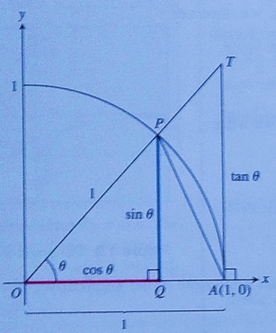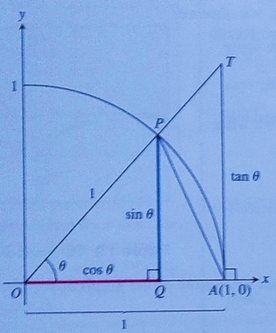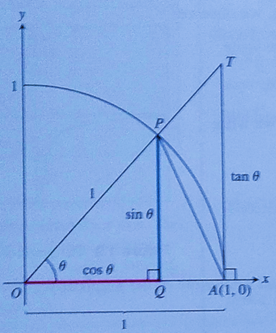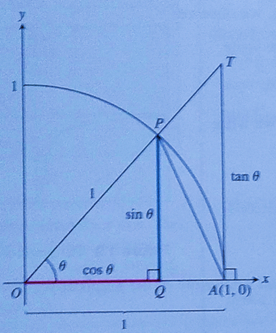
(a.)
To explain: Why limit is restricted to

(a.)
Answer to Problem 77E
From the figure it can be observed that the graph of the function lies between
Explanation of Solution
Given:
The given figure is shown below:

Consider the given graph.
It is known that an output value that a function approaches for the specified input values is referred to as a limit.
From the given figure it can be observed that the value of the function or the limit of the function when x approaching to 0 is depends only for the positive x values near zero. This is why limit is restricted to
(b.)
To Prove: The area of
(b.)
Explanation of Solution
Given:
The given figure is shown below:

Concept used:
Area of triangle is:
Area of sector is:
Calculation:
Consider the given figure.
From the figure it can be observed that, in
Put
Consider the sector
From the figure it can be observed that, in sector
Use the area of the sector formula:
Consider the triangle
From the figure it can be observed that, in
Put
(c.)
To Prove: That
(c.)
Explanation of Solution
Given:
From part (b) The area of
The given figure is shown below:

Concept used:
In a right-angled triangle one of its angles is
Calculation:
Consider the given information.
The triangle given in the figure is right angle triangle and in a right angle triangle one angle is
Also, it is known that the area of
Now observe the value of
Also, from the figure it can be observed that
Therefore,
(d.)
To Prove: That
(d.)
Explanation of Solution
Given:
The given inequality is:
Concept used:
Domain of a function is the set of input values which a function can take.
Calculation:
Consider the given inequality.
Mulitiply each side of the inequality by 2.
Now divide each side by
(e.)
To Prove: That
(e.)
Explanation of Solution
Given:
The given inequality is:
Concept used:
Domain of a function is the set of input values which a function can take.
Calculation:
Consider the given inequality.
Taking reciprocal of the above inequality and change the direction of the inequlaity.
(f.)
To Prove:
(f.)
Explanation of Solution
Given:
The given limit is
Concept used:
The squeeze theorem states that if
Calculation:
Consider the given information.
From part (e) it is known that
Applying limit on each function.
Let
Thus,
Let
Thus,
Therefore, by the squeeze theorem
(g.)
To Prove: That
(g.)
Explanation of Solution
Given:
The given function is
Concept used:
A function is said to be even if
Calculation:
Consider the given function.
Replace
Since
(h.)
To Prove: That
(h.)
Explanation of Solution
Given:
From part (g) it is known that
Concept used:
The squeeze theorem states that if
Calculation:
Consider the given limit.
Take
Therefore,
(i.)
To Prove:
(i.)
Explanation of Solution
Given:
From part (f) and (h) it is known that
Concept used:
The limit of a function as it approaches from the left is referred to as the left-hand limit. The limit of a function as it approaches from the right-hand side is referred to as a right-hand limit.
Calculation:
Consider the given information.
From part (f) and (h) it is known that
If the function has both limits defined at a particular x value c and those values match, then the limit will exist and will be equal to the value of the one-sided limits.
Since the left- and right-hand limits are equal so
Therefore,
Chapter 1 Solutions
CALCULUS:GRAPHICAL,...,AP ED.-W/ACCESS
- Points z1 and z2 are shown on the graph.z1 is at (4 real,6 imaginary), z2 is at (-5 real, 2 imaginary)Part A: Identify the points in standard form and find the distance between them.Part B: Give the complex conjugate of z2 and explain how to find it geometrically.Part C: Find z2 − z1 geometrically and explain your steps.arrow_forwardA polar curve is represented by the equation r1 = 7 + 4cos θ.Part A: What type of limaçon is this curve? Justify your answer using the constants in the equation.Part B: Is the curve symmetrical to the polar axis or the line θ = pi/2 Justify your answer algebraically.Part C: What are the two main differences between the graphs of r1 = 7 + 4cos θ and r2 = 4 + 4cos θ?arrow_forwardA curve, described by x2 + y2 + 8x = 0, has a point A at (−4, 4) on the curve.Part A: What are the polar coordinates of A? Give an exact answer.Part B: What is the polar form of the equation? What type of polar curve is this?Part C: What is the directed distance when Ø = 5pi/6 Give an exact answer.arrow_forward
- New folder 10. Find the area enclosed by the loop of the curve (1- t², t-t³)arrow_forward1. Graph and find the corresponding Cartesian equation for: t X== y = t +1 2 te(-∞, ∞) 42,369 I APR 27 F5 3 MacBook Air stv A Aa T 4 DIIarrow_forwardMiddle School GP... Echo home (1) Addition and su... Google Docs Netflix Netflix New folder 9. Find the area enclosed by x = sin²t, y = cost and the y-axis.arrow_forward
- 2. Graph and find the corresponding Cartesian equation for: (4 cos 0,9 sin 0) θ ε [0, 2π) 42,369 I APR 27 3 MacBook Air 2 tv A Aaarrow_forward30 Page< 3. Find the equation of the tangent line for x = 1+12, y = 1-3 at t = 2 42,369 APR A 27 M . tv NA 1 TAGN 2 Aa 7 MacBook Air #8arrow_forwardEvaluate the following integrals as they are writtenarrow_forward
- Calculus lll May I please have the blank lines completed, and final statement defined as a result? Thank you for the support!arrow_forward3. Consider the polynomial equation 6-iz+7z² - iz³ +z = 0 for which the roots are 3i, -2i, -i, and i. (a) Verify the relations between this roots and the coefficients of the polynomial. (b) Find the annulus region in which the roots lie.arrow_forwardForce with 800 N and 400 N are acting on a machine part at 30° and 60°, respectively with the positive x axisarrow_forward
 Calculus: Early TranscendentalsCalculusISBN:9781285741550Author:James StewartPublisher:Cengage Learning
Calculus: Early TranscendentalsCalculusISBN:9781285741550Author:James StewartPublisher:Cengage Learning Thomas' Calculus (14th Edition)CalculusISBN:9780134438986Author:Joel R. Hass, Christopher E. Heil, Maurice D. WeirPublisher:PEARSON
Thomas' Calculus (14th Edition)CalculusISBN:9780134438986Author:Joel R. Hass, Christopher E. Heil, Maurice D. WeirPublisher:PEARSON Calculus: Early Transcendentals (3rd Edition)CalculusISBN:9780134763644Author:William L. Briggs, Lyle Cochran, Bernard Gillett, Eric SchulzPublisher:PEARSON
Calculus: Early Transcendentals (3rd Edition)CalculusISBN:9780134763644Author:William L. Briggs, Lyle Cochran, Bernard Gillett, Eric SchulzPublisher:PEARSON Calculus: Early TranscendentalsCalculusISBN:9781319050740Author:Jon Rogawski, Colin Adams, Robert FranzosaPublisher:W. H. Freeman
Calculus: Early TranscendentalsCalculusISBN:9781319050740Author:Jon Rogawski, Colin Adams, Robert FranzosaPublisher:W. H. Freeman
 Calculus: Early Transcendental FunctionsCalculusISBN:9781337552516Author:Ron Larson, Bruce H. EdwardsPublisher:Cengage Learning
Calculus: Early Transcendental FunctionsCalculusISBN:9781337552516Author:Ron Larson, Bruce H. EdwardsPublisher:Cengage Learning





